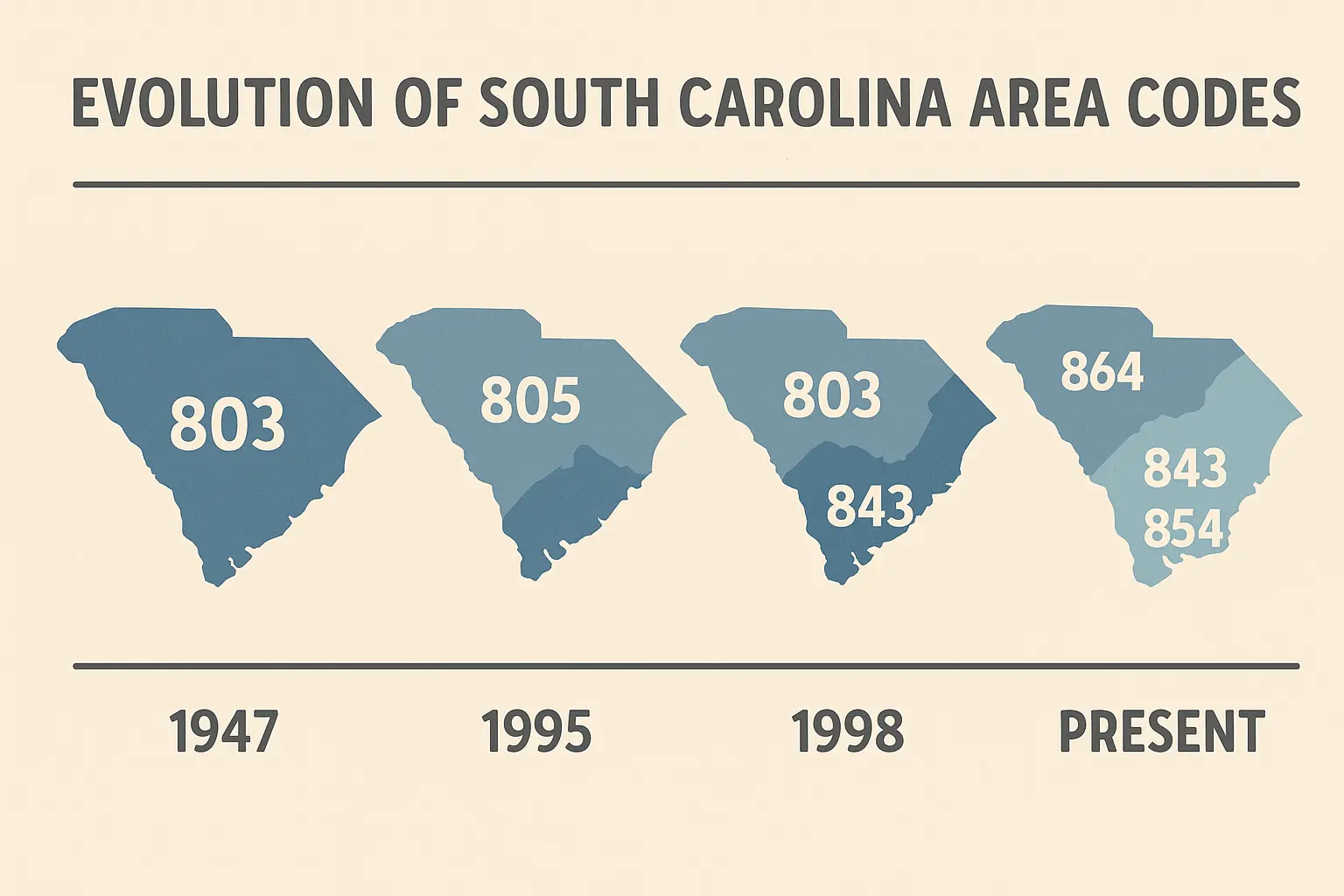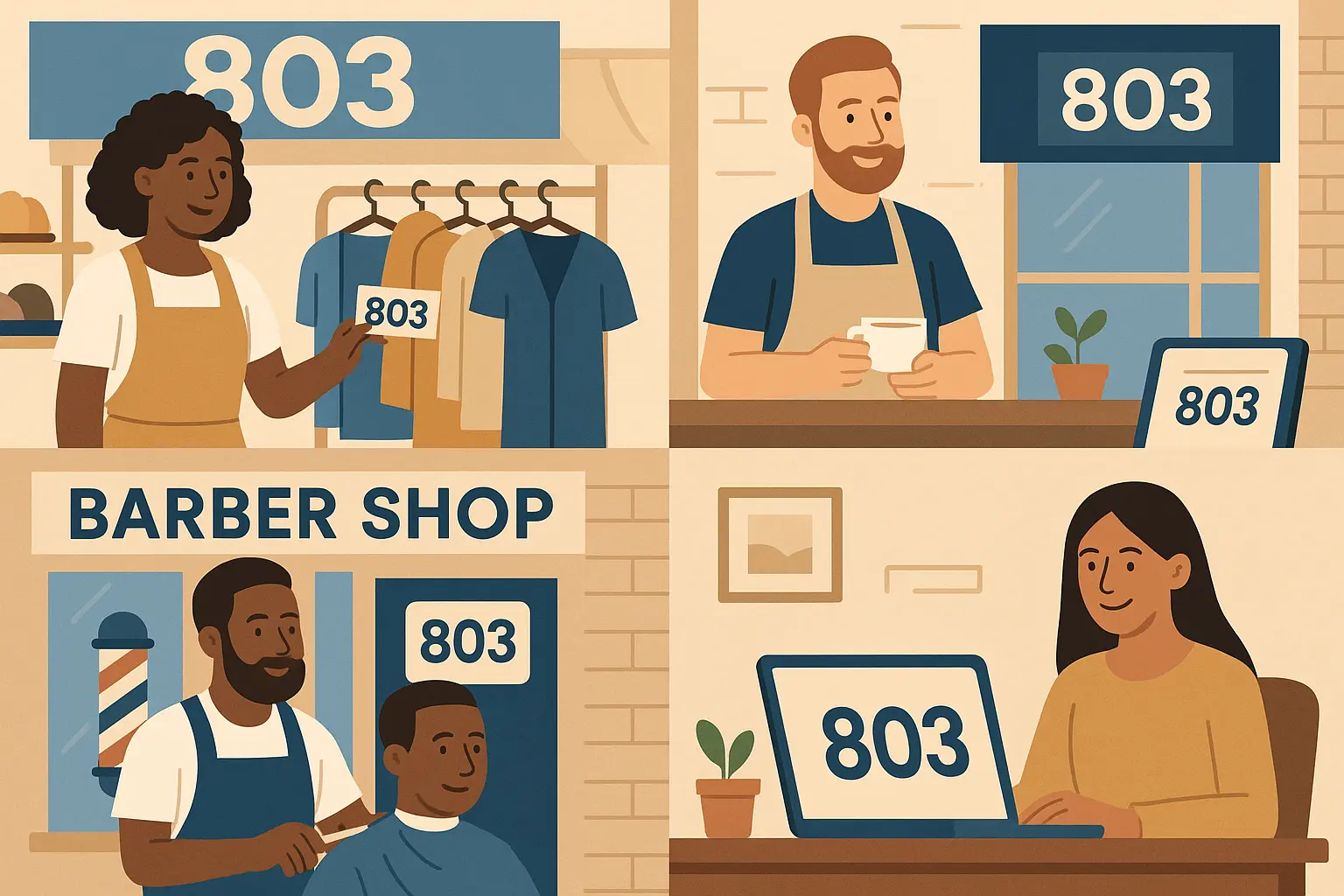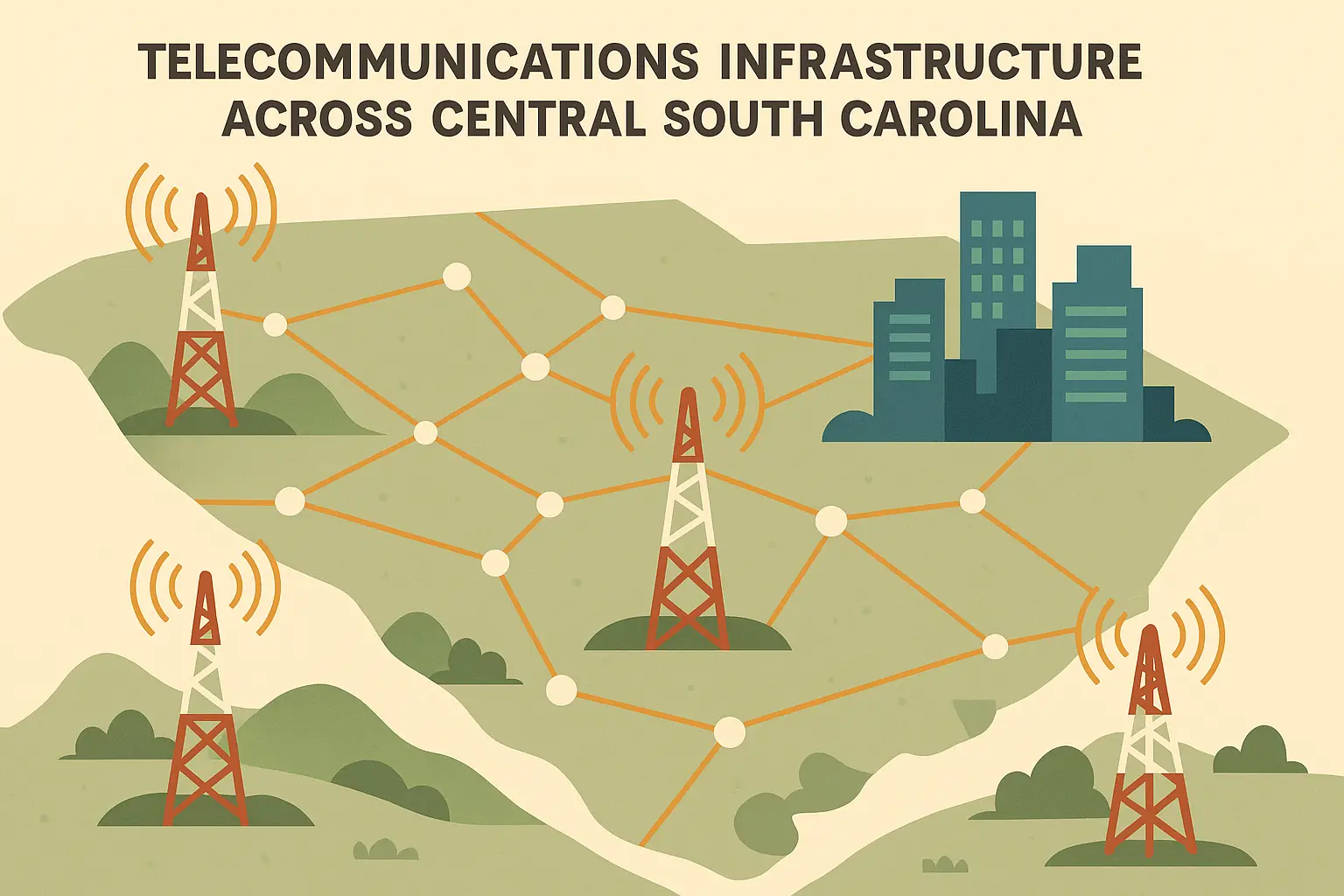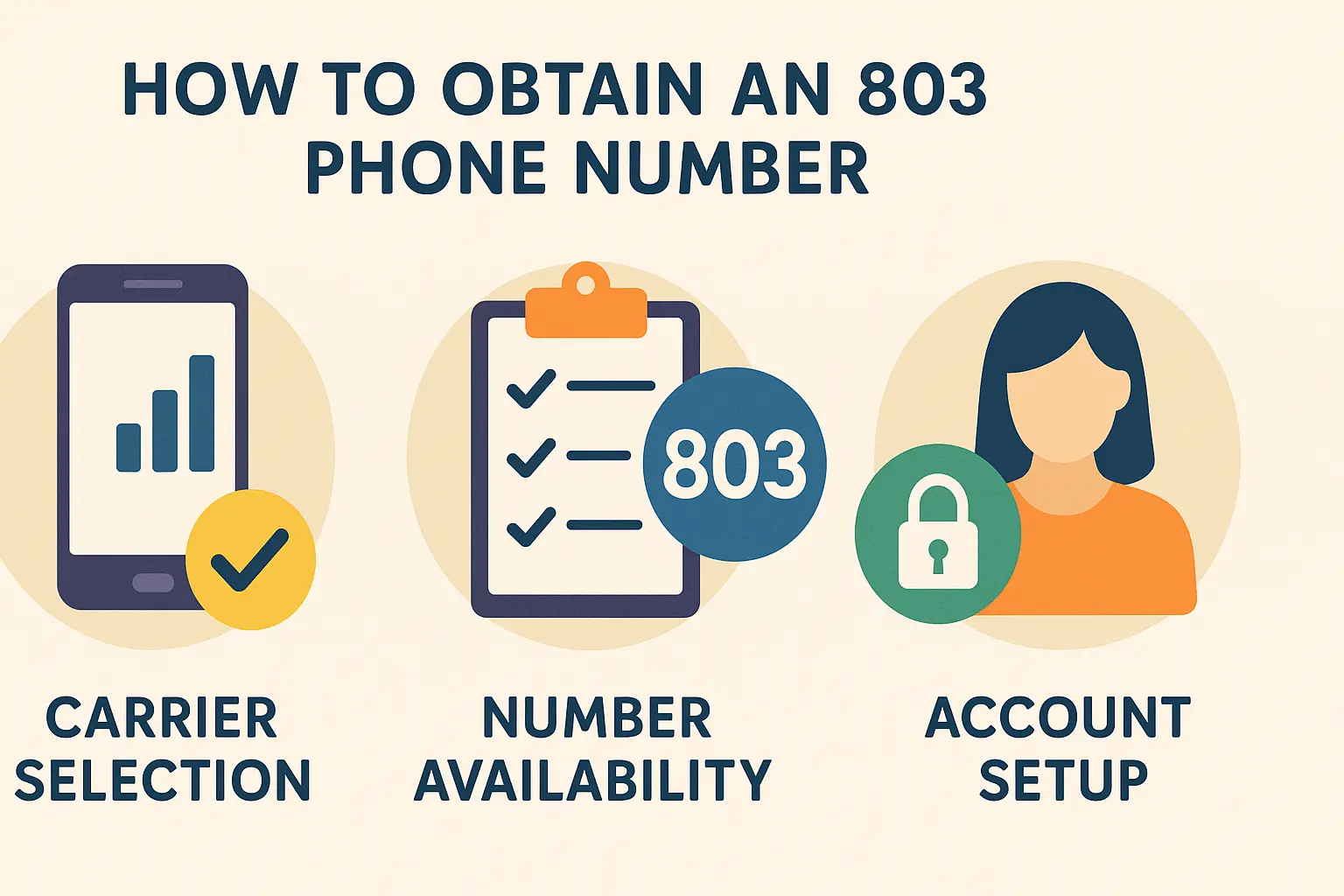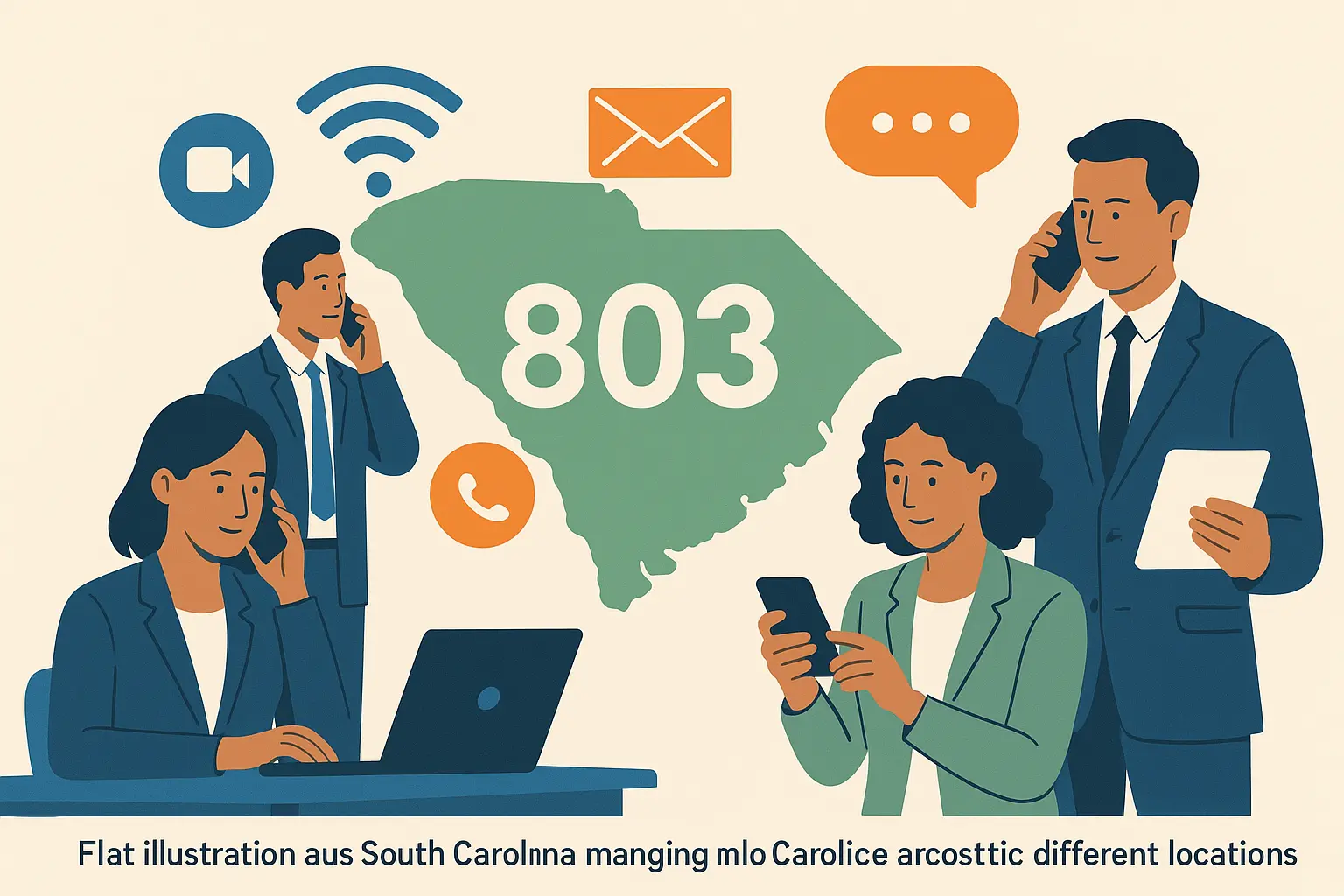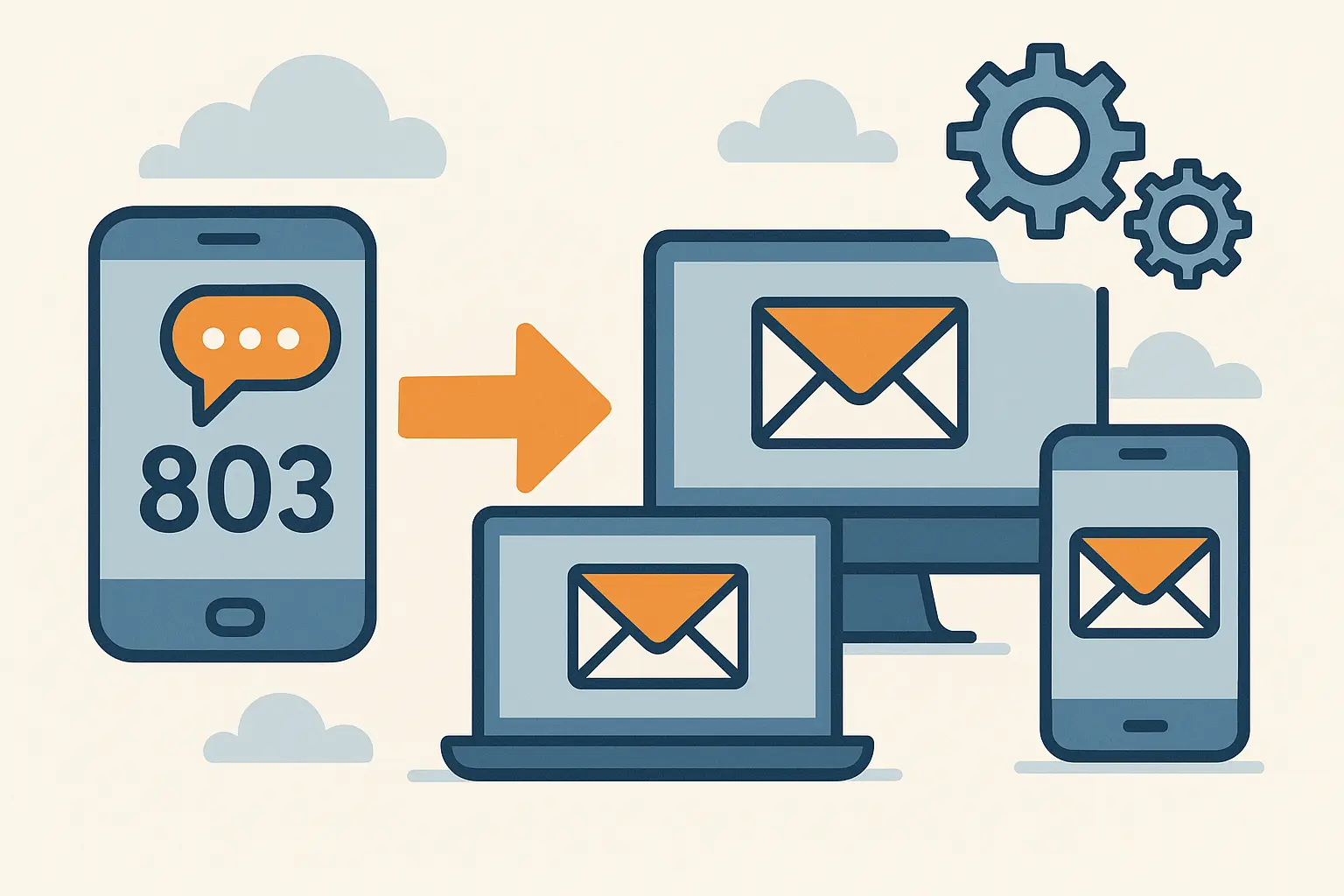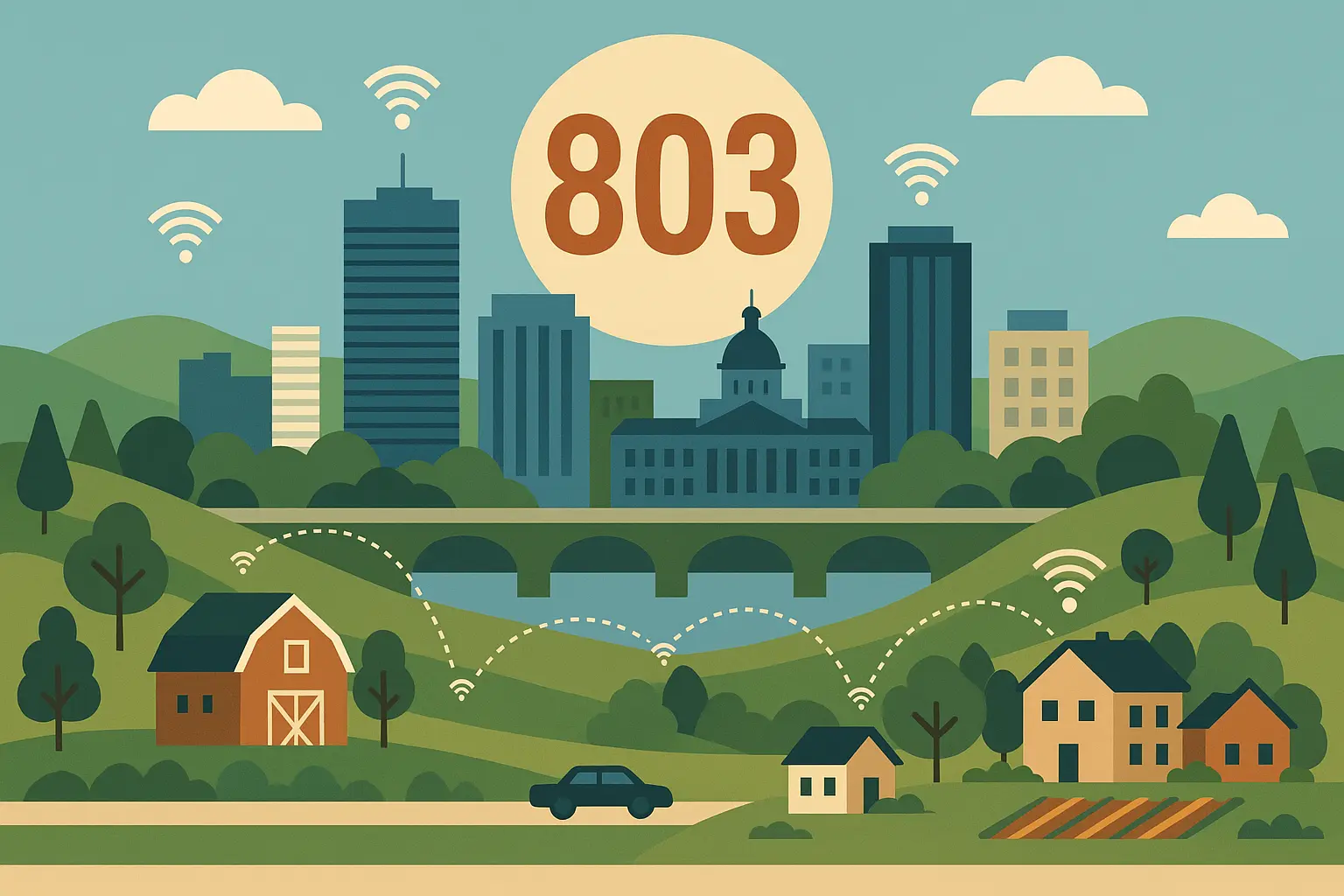Got a phone number that starts with 803? You’re part of central South Carolina’s telecommunications family. This area code covers about 1.7 million people across the heart of the state, from Columbia’s bustling downtown to quiet farming communities scattered throughout the region.
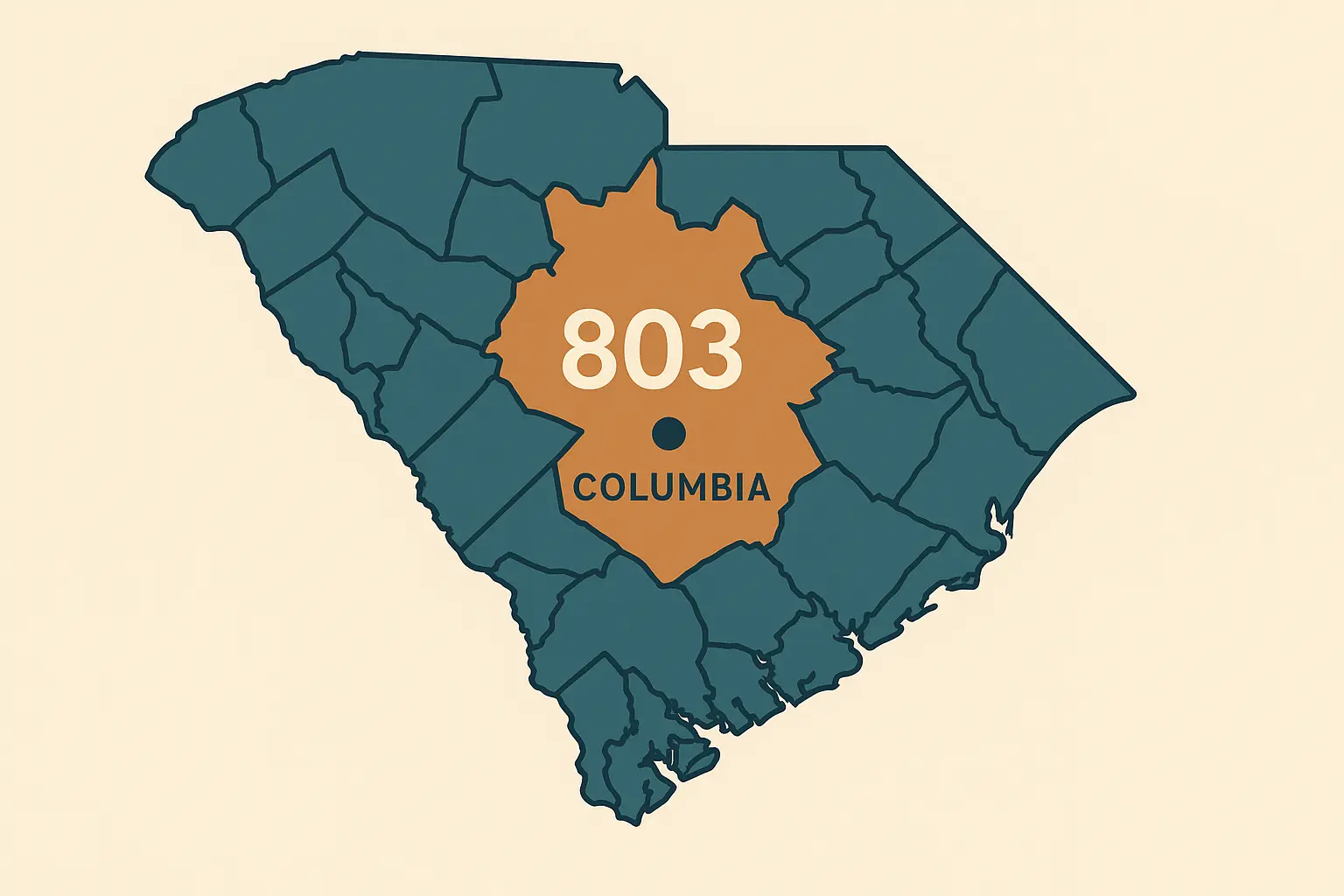
Table of Contents
Table of Contents
-
Geographic Coverage and Service Area
-
Historical Development and Evolution
-
Business and Communication Applications
-
Technical Infrastructure and Network Details
-
Practical Usage and Implementation
-
Enhanced Communication Solutions for 803 Users
-
Final Thoughts
TL;DR
-
803 serves central South Carolina, covering Columbia and surrounding areas after being split from statewide coverage in 1998 and 2000
-
Originally assigned to the entire state in 1947, 803 now focuses on Richland County, Lexington County, and other central regions
-
Businesses use 803 numbers for local credibility and customer trust, while individuals benefit from number portability options
-
Modern infrastructure supports both traditional and VoIP services with extensive cellular coverage
-
Message forwarding solutions help 803 users stay connected across devices while preserving their local identity
Geographic Coverage and Service Area
The 803 region represents the heart of South Carolina, covering Columbia and the surrounding central area. After decades of serving the entire state, this area code now focuses specifically on the capital region and nearby communities. Understanding where 803 covers helps you determine if you’re dealing with local calls or need to consider long-distance charges.
Columbia and the Metropolitan Powerhouse
Columbia stands as the center of 803 territory, housing state government operations, the University of South Carolina, and major business districts. The metropolitan area extends beyond the city limits to include rapidly growing suburban communities that have transformed the region’s communication needs.
The Capital City’s Communication Hub
Columbia anchors everything in the 803 region. State government workers, university students and faculty, plus all the businesses that support them create constant communication activity throughout the day.
The University of South Carolina alone brings in tens of thousands of students who need local numbers for everything from apartment hunting to part-time jobs. Many keep their 803 numbers long after graduation because it connects them to this place they called home for four years.
The local community’s pride in the 803 was recently showcased when Columbia native 803Fresh brought his viral hit “Boots on the Ground” to South Carolina State University for a music video shoot, as reported by “HBCU Gameday”. The artist, whose stage name proudly reflects his area code roots, celebrated the cultural significance of central South Carolina while working with the famed Marching 101 Band.
Secondary Cities That Matter
Beyond Columbia, several cities provide essential regional services and contribute significantly to the area’s economic diversity. These communities maintain their own distinct identities while sharing the common thread of central South Carolina’s area code.
Aiken brings its own flavor to the 803 mix – equestrian culture and proximity to Augusta, Georgia create unique calling patterns. People there often find themselves dialing across state lines for business or social connections.
Sumter and Camden each serve as regional hubs for their surrounding rural areas. When someone from a small farming community needs to call their bank, doctor, or government office, they’re often dialing into one of these secondary cities within the 803 network.
Rural Communities Stay Connected
Smaller towns and farming communities throughout central South Carolina depend on 803 numbering for essential communication infrastructure. These areas face unique challenges in maintaining reliable service while contributing to the area code’s overall character.
Rural 803 areas tell a different story than the urban centers. Farming communities, small manufacturing towns, and residential areas scattered between the bigger cities all rely on this numbering system to stay connected to essential services and each other.
People in these smaller communities often have stronger attachments to their 803 numbers. It’s proof they belong to this central South Carolina region, even when they might be 30 minutes from the nearest traffic light.
County-by-County Breakdown
The 803 region breaks down into a few key areas, each with its own personality. Columbia and Richland County are where most of the action happens – state government, the university, and tons of businesses all competing for memorable numbers.
|
County |
Primary Cities |
Population Characteristics |
Communication Patterns |
|---|---|---|---|
|
Richland |
Columbia, Forest Acres |
Dense urban core, university students |
High volume business/government calls |
|
Lexington |
West Columbia, Cayce |
Suburban growth, families |
Residential lines, commuter patterns |
|
York |
Rock Hill, Fort Mill |
Border proximity to NC |
Cross-state calling common |
|
Sumter |
Sumter, Shaw AFB |
Military presence |
Government/military communications |
|
Aiken |
Aiken, North Augusta |
Equestrian culture, GA border |
Interstate business connections |
Head west to Lexington County and you’ll find suburban growth everywhere. New neighborhoods mean constant demand for fresh 803 numbers. The suburban nature creates interesting communication patterns – families often have multiple lines with 803 numbers that help maintain their local identity even as they commute to Columbia for work.
Down in Aiken, the equestrian crowd creates interesting calling patterns since many folks do business across the Georgia border. Rural communities scattered throughout might be 30 minutes from the nearest traffic light, but they’re still proudly 803.
Border Dynamics and Regional Connections
Understanding where 803 sits in South Carolina helps clarify service boundaries and potential calling considerations. The region maintains strong communication ties with adjacent areas and major southeastern metropolitan centers.
Where 803 Meets Other Area Codes
Border areas can get confusing. You might live in 803 territory but work just across the line in 843 or 864 country. This creates situations where your “local” calls might actually be long-distance, depending on your service plan.
Businesses sometimes struggle with this, especially when they’re trying to serve customers on both sides of an area code boundary. Do you get numbers in both area codes? How do you handle the marketing and customer service implications?
Interstate Communication Patterns
The 803 region doesn’t exist in isolation. Charlotte’s influence reaches down into the area, and Atlanta’s business connections run strong too. Many 803 users find themselves regularly calling or texting across state lines for work or family reasons.
This interstate connectivity affects how people choose their phone plans and communication tools. You want something that handles those cross-border calls efficiently without breaking the bank.
Historical Development and Evolution
The 803 carries decades of South Carolina communication history, evolving from serving the entire state to its current focused coverage of central regions. This transformation reflects broader changes in population growth, technology adoption, and telecommunications infrastructure development.
From Statewide Service to Regional Focus
Originally covering all of South Carolina when the North American Numbering Plan launched in 1947, 803 has undergone significant geographic reductions as the state’s population grew and communication needs became more complex.
The Original Statewide Era
Back in 1947, all of South Carolina shared 803. The whole state! There simply weren’t enough people or phone lines to justify multiple codes. Rural areas took years to fully adopt the new numbering system. Many places still relied on operators to connect calls, and the idea of dialing seven or ten digits seemed unnecessarily complicated to folks who were used to asking the operator to “connect me to Doc Johnson.”
The system worked fine when most people had one phone line in their house and businesses operated primarily within their immediate communities.
The Great Splits Begin
The first big change came in 1998 when they carved out 843 for the coastal areas. Charleston, Myrtle Beach, and all those beach communities got their own area code. Suddenly, 803 wasn’t statewide anymore.
Then 2000 brought another split – 864 took over the upstate region around Greenville and Spartanburg. These weren’t just administrative changes; they represented real shifts in how South Carolinians thought about their regional identities and communication patterns.
The confusion during those transition periods was real. People had to learn new dialing patterns, update their business cards, and figure out whether their “local” calls were still actually local.
Modern Number Management Reality
Today’s 803 operates under sophisticated allocation systems designed to maximize efficiency while meeting growing communication demands. Understanding current management practices helps users navigate availability and plan for future needs.
How Numbers Get Distributed Today
Getting a specific 803 number isn’t as simple as it used to be. Carriers manage blocks of numbers based on geographic areas, business versus residential needs, and what’s actually available at any given time.
Large companies and government agencies often get dedicated number blocks. This ensures they can have consistent numbering for their various departments while maintaining that local 803 identity that’s important for their operations.
For regular folks, you typically get assigned whatever’s available in your area. Sometimes you luck out with a memorable combination, other times you’re stuck with something that looks generated by a random number machine.
Understanding the proper formatting for phone numbers becomes crucial when businesses need to display their 803 numbers in marketing materials or international communications.
Planning for the Future
The people managing our numbering resources are always looking ahead. Columbia keeps growing, more businesses move in, and everyone seems to need multiple phone lines these days. Will 803 numbers eventually run out?
Technology changes everything too. VoIP services, business phone systems, and mobile communications all affect how numbers get used. Some businesses need dozens of numbers for different departments or call routing purposes.
There’s always talk about potential overlay area codes – where they’d add a second area code to the same geographic region. Nobody wants that complexity, but it might become necessary if growth continues at current rates.
Business and Communication Applications
Businesses throughout the 803 region use local numbering strategically to build customer trust, establish community presence, and coordinate complex communication needs. From small local shops to major corporations, 803 serves as both a practical tool and a marketing asset.
Building Local Business Credibility
Companies operating in the 803 region leverage local numbering to demonstrate community commitment and accessibility to customers throughout central South Carolina. This local presence often translates directly into customer trust and business success.
The 803 region serves as an economic hub for central South Carolina, with key sectors including government, education, healthcare, manufacturing, and insurance, as noted by telecommunications industry analysis from “Phonely AI”. Major employers include the University of South Carolina, BlueCross BlueShield of South Carolina, Palmetto Health, and state government agencies, all of which rely heavily on local 803 numbers for their operations.
The Trust Factor of Local Numbers
There’s something powerful about seeing an 803 number on a business card or website. It immediately tells you this company understands the local market, probably has real people you can reach, and isn’t some distant call center operation.
Local businesses struggle when they try to save money with out-of-state phone services that give them random area codes. Customers see a 312 or 702 number and assume they’re dealing with some fly-by-night operation, even when the business is right down the street.
Smart businesses make their 803 numbers prominent in their marketing. It’s proof they belong to this community and understand what matters to people here.
Marketing Your Local Roots
You’ll see 803 numbers featured prominently in local radio ads, billboards, and newspaper advertisements. It’s become a shorthand way of saying “we’re your neighbors” without having to spell it out explicitly.
Some businesses get creative with their 803 number marketing. They’ll use it in jingles, make it part of their logo design, or even incorporate it into their business name or slogan. The area code becomes part of their brand identity.
This local marketing approach works especially well for service businesses – contractors, real estate agents, restaurants, and professional services. People want to know they can reach someone who understands their specific needs and local conditions.
Complex Business Communication Coordination
Companies with multiple locations use 803 numbers as part of broader communication strategies that may include call forwarding, unified messaging systems, and sophisticated customer service operations.
Managing Multiple Locations
Multi-location businesses face interesting challenges with 803 numbers. They want to maintain local presence in each area they serve, but they also need efficient ways to route calls and messages to the right people.
Some companies assign different 803 numbers to different locations or departments, then use call forwarding to ensure someone always answers. Others use a single main 803 number with sophisticated routing that directs callers based on their needs or location.
The key is making it seamless for customers while giving the business flexibility in how they handle communications internally. Nobody wants to get bounced around between different numbers or locations when they’re trying to get help.
Many businesses discover they need to forward text messages to email to ensure their 803 customer communications reach the right team members regardless of location.
Supporting Remote Work Realities
Remote work has changed everything about business communications. Companies still want that local 803 presence, but their employees might be working from home, traveling, or even living in other states.
Call forwarding and VoIP solutions let businesses maintain their 803 numbers while routing calls to wherever their team members actually are. A customer calls the local 803 number, but the call might get answered by someone working from their home office in Lexington or even from a coffee shop in Charleston.
This flexibility helps businesses attract and retain good employees while still serving their local customer base effectively. The 803 number becomes the consistent face of the business, even when the actual operations are more distributed.
Personal Communication Challenges and Solutions
Individuals with 803 numbers often need solutions for managing communications across multiple devices and platforms while maintaining their local identity. Life changes, technology upgrades, and mobility requirements create ongoing challenges.
Keeping Your 803 Identity While Life Changes
Life happens, and sometimes that means your 803 number needs to work in new ways. Maybe you’re moving across town, across the state, or even across the country. Do you keep your 803 number or get something local to your new area?
Federal regulations let you port your 803 number to different carriers and even different geographic areas, but there can be complications. Some features might not work the same way, costs could change, and you might face technical limitations depending on where you’re moving.
People hold onto their 803 numbers for years after moving away because it maintains their connection to home. Family and friends know that number, local businesses have it on file, and it’s part of their identity in ways that go beyond just communication.
A University of South Carolina graduate who moves to Charlotte for work might keep their 803 number and use call forwarding to their new North Carolina phone. This allows them to maintain connections with Columbia-area contacts, local banks, and healthcare providers while establishing new relationships in their new city.
Managing Multiple Devices and Platforms
These days, your 803 number isn’t just tied to one phone sitting on your kitchen counter. You want it to work on your smartphone, maybe ring through to your tablet, integrate with your email, and possibly even work through your computer.
Getting all these devices to play nicely together with your 803 number can be tricky. Different carriers and services have different capabilities, and what works great on one device might be clunky on another.
The goal is seamless communication – when someone texts or calls your 803 number, you want to be able to respond from whatever device is most convenient at the moment, without the other person knowing or caring about the technical complexity behind the scenes.
Technical Infrastructure and Network Details
The 803 operates on sophisticated telecommunications infrastructure that combines traditional landline networks with modern cellular and fiber optic systems. Understanding this technical foundation helps users make informed decisions about service providers and communication reliability.
The Network That Powers 803 Communications
Telecommunications infrastructure supporting the 803 region includes extensive cellular tower networks, expanding fiber optic installations, and traditional switching systems that work together to ensure reliable communication services across urban and rural areas.
Cellular Coverage Across Central South Carolina
Cell coverage in 803 territory is solid if you stick to Columbia and the main highways. Rural areas can be spotty – you might have full bars in town but lose signal on back roads.
Highway coverage along I-77, I-20, and I-26 is generally reliable since carriers prioritize these major travel routes. But venture off onto some of the back roads, and you’re taking your chances with connectivity.
Fiber Optic Expansion Changes Everything
Fiber internet is changing everything, especially for business phone systems. Columbia and suburbs are getting aggressive fiber rollouts from multiple providers. This competition benefits everyone through better service quality and more competitive pricing.
Rural areas are still waiting for comprehensive fiber coverage, but it’s coming gradually. Federal and state programs are helping fund these expansions, recognizing that reliable internet infrastructure is essential for modern communication needs.
Service Provider Landscape and Options
Multiple telecommunications companies serve the 803 region, offering various options for obtaining and managing local numbers. The competitive landscape includes national carriers, regional providers, and specialized VoIP services.
With 57.1% of the 803 region’s population actively participating in the labor force according to ZipAtlas employment data, reliable business communications infrastructure becomes crucial for supporting the area’s economic activity and workforce connectivity needs.
Major Carriers Dominate the Market
The big national carriers (Verizon, AT&T, T-Mobile) all compete here, which usually means better deals. Each carrier has its strengths and weaknesses in different parts of the region. One might have better coverage in rural Lexington County while another excels in downtown Columbia.
Business customers often get priority treatment and enhanced features from these major carriers. If you’re running a company that depends heavily on reliable 803 communications, the extra cost for business-grade service usually pays for itself.
Regional Providers Offer Personal Touch
Don’t overlook smaller regional providers operating in 803 territory. These companies often provide more personalized customer service and can be more flexible with custom solutions.
Regional providers sometimes understand the specific communication needs of central South Carolina better than national companies. They’re also more likely to have local customer service representatives who actually know the area.
The trade-off is usually more limited coverage areas and fewer advanced features compared to the major carriers. But for many users, especially small businesses, the personalized service makes up for these limitations.
VoIP Services Add Flexibility
VoIP has revolutionized how people think about 803 numbers. You can get an 803 number through a VoIP provider and use it anywhere you have a decent internet connection, not just within the traditional coverage area.
This flexibility is huge for businesses with remote workers or people who travel frequently but want to maintain their local 803 identity. The number stays the same, but the actual service can follow you wherever you go.
Quality depends heavily on your internet connection, though. A fiber connection in Columbia will give you crystal-clear VoIP calls, but trying to use VoIP over a spotty rural internet connection can be frustrating for everyone involved.
Practical Usage and Implementation
Successfully obtaining and managing 803 numbers requires understanding carrier policies, availability constraints, and ongoing maintenance requirements. From initial acquisition through daily usage optimization, effective number management involves both technical considerations and practical strategies.
Getting Your Hands on an 803 Number
The process of acquiring a new 803 number involves navigating carrier policies, checking availability, and selecting appropriate features to meet specific communication needs. Business and residential accounts offer different options and pricing structures.
Checking Availability and Making Selections
Getting an 803 number isn’t complicated, but popular combinations go fast. Anything with repeating digits, sequential numbers, or easy-to-remember patterns gets snapped up quickly or costs extra money.
Most carriers let you search available numbers online, but the selection changes constantly as people activate new lines or cancel existing ones. What’s available today might be gone tomorrow, so don’t spend too much time deliberating if you find something you like.
Geographic preferences matter too. Some carriers assign numbers based on specific exchanges that correspond to different parts of the 803 region. If having a “Columbia” number versus a “Lexington” number matters to you, make sure to specify that when you’re shopping around.
Business vs. Residential Account Considerations
Business accounts cost more but include features worth the money – priority support, better call forwarding, integration with business software. For most personal use, residential accounts work fine.
Here’s what actually matters: think about how you’ll really use the number. Simple personal calls? Go residential. Running any kind of business? The business features usually pay for themselves.
For businesses managing customer communications, learning how to forward text messages on Android ensures 803 messages reach team members across different devices and platforms.
Advanced Features That Actually Matter
Modern 803 number services include sophisticated features that enhance communication effectiveness and professional presentation. Understanding and properly configuring these features can significantly improve communication outcomes.
Call Forwarding That Works for You
Call forwarding has evolved way beyond just sending calls to another number. Modern systems let you create rules based on who’s calling, what time it is, whether you’re available, or even what day of the week it is.
You can set up your 803 number to ring your office phone during business hours, forward to your cell phone in the evenings, and go straight to voicemail on weekends. Or create VIP lists where certain callers always get through while others go to voicemail during specific times.
The key is thinking through your actual communication patterns and setting up rules that match how you really work and live. Overly complex forwarding rules can create more problems than they solve, so start simple and add complexity only when you need it.
Voicemail and Messaging Integration
Voicemail isn’t just about recording messages anymore. Modern systems can transcribe voicemails and email them to you, forward messages to multiple people, or even integrate with business software to automatically log customer interactions.
Email integration is particularly useful – you can read voicemail transcriptions while you’re in meetings, forward important messages to colleagues, and keep everything organized in your existing email system rather than having to call in to check messages.
Some systems even let you respond to voicemails via text message or email, creating a more flexible communication flow that works better with how people actually communicate today.
Troubleshooting and Optimization Strategies
Effective use of 803 numbers requires understanding common issues and implementing solutions that maintain reliable communication. From message delivery problems to integration challenges, systematic troubleshooting approaches help maintain professional communication standards.
Common Technical Issues You’ll Encounter
The most annoying 803 problems? Text messages that arrive hours late or don’t show up at all. This usually happens during peak hours around Columbia or when carriers get overly aggressive with spam filtering.
Call quality issues typically mean internet problems if you’re using VoIP, or you’ve hit a dead zone if you’re on cellular. Network congestion during peak hours can cause problems, especially in densely populated areas around Columbia during rush hour or major events.
VoIP calls are particularly sensitive to internet connection quality – a slight hiccup in your broadband service can make your 803 calls sound choppy or drop entirely.
|
Common Issue |
Symptoms |
Likely Causes |
Quick Solutions |
|---|---|---|---|
|
SMS Delays |
Messages arrive hours late |
Network congestion, carrier filtering |
Switch to different carrier, avoid peak hours |
|
Call Quality Problems |
Choppy audio, dropped calls |
Poor internet connection, device issues |
Check internet speed, restart device |
|
Forwarding Failures |
Calls don’t reach destination |
Incorrect settings, carrier limitations |
Verify forwarding numbers, test settings |
|
Integration Issues |
Software doesn’t sync |
API compatibility problems |
Contact provider support, update software |
|
Coverage Gaps |
No signal in certain areas |
Geographic dead zones |
Use WiFi calling, consider signal booster |
Integration Compatibility Challenges
Getting your 803 number to work smoothly with business software can be tricky. Customer relationship management systems, scheduling software, and communication platforms all have their own requirements and limitations.
Don’t assume everything will work together automatically. Test integrations thoroughly before relying on them for important business communications, and have backup plans ready when technical issues inevitably arise.
Performance Optimization That Makes a Difference
Maximizing the effectiveness of 803 communications involves implementing best practices for reliability, professional presentation, and operational efficiency. These strategies help users get the most value from their local numbering investment.
Building Redundancy Into Your Communication Plan
Single points of failure will eventually bite you. If your business depends on your 803 number, you need backup plans for when things go wrong – and they will go wrong at some point.
Multiple carriers, backup internet connections, and alternative communication methods (email, messaging apps, even old-fashioned landlines) can keep you connected when your primary 803 service has problems.
The goal isn’t to create an overly complex system, but to have simple alternatives ready when you need them. A backup mobile hotspot and a secondary 803 number on a different carrier might be all you need to avoid communication disasters.
Given that the median household income in the 803 area is $54,805 according to ZipAtlas income data, businesses and individuals need cost-effective communication solutions that provide reliable service without breaking the budget, making redundancy planning an important financial consideration.
Message Management Workflows
High message volumes can overwhelm even the most organized person. Creating systematic workflows for handling 803 communications helps ensure nothing important gets missed while maintaining reasonable response times.
Filtering and prioritization systems help separate urgent messages from routine communications. Automated responses can acknowledge receipt and set expectations for response times. Forwarding rules can route different types of messages to appropriate team members.
The key is finding a balance between automation and personal touch. Customers want to know their messages are being handled efficiently, but they also want to feel they’re communicating with real people who care about their needs.
803 Communication Management Checklist:
-
Set up automatic message acknowledgments for business hours
-
Create priority contact lists for urgent communications
-
Establish response time goals (2 hours for business, 24 hours for general)
-
Configure message forwarding rules for team members
-
Test backup communication methods monthly
-
Review and update contact information quarterly
-
Monitor message delivery success rates
-
Document common issues and solutions
Enhanced Communication Solutions for 803 Users
Auto Forward SMS provides specialized capabilities that address unique challenges faced by 803 users in both business and personal contexts. The platform offers solutions for maintaining local presence while supporting distributed teams, ensuring compliance requirements, and managing complex communication needs across multiple devices and locations.
Addressing Real 803 Communication Pain Points
Companies and individuals in the 803 region face specific challenges related to message management, compliance requirements, and maintaining local connections while adapting to modern communication demands. These challenges require targeted solutions that understand the regional context.
Business Communication Enhancement for Central South Carolina
Running a business in the 803 area means juggling local customer expectations with modern operational realities. Your customers expect quick responses to their text messages, but your team might be spread across different locations or working flexible schedules.
Auto Forward SMS solves this by ensuring every message to your 803 business number gets forwarded to the right people via email, regardless of where they’re working. Your customer service rep can respond to SMS messages from their laptop while working from home, maintaining that personal touch customers expect from local businesses.
The platform’s filtering capabilities are particularly valuable for 803 businesses that receive high volumes of messages from various sources – customer inquiries, vendor communications, appointment confirmations, and promotional responses all get sorted automatically so the right people see the right messages.
The growing community pride around the 803 was recently celebrated during “803 Day” as reported by WIS TV, where the celebration expanded into a full weekend of events honoring the people, culture, and communities that represent the heart of the 803 region. This local identity strengthens the importance of maintaining authentic 803 communication connections for businesses.
Businesses can streamline their workflow by learning how to forward text messages to Slack channels, ensuring 803 customer communications integrate seamlessly with team collaboration platforms.
Government and Public Service Applications
Government agencies and public service organizations in the Columbia area deal with communication challenges that private businesses don’t face. Citizens expect 24/7 accessibility, emergency situations require immediate response, and compliance requirements demand complete message retention.
Message forwarding ensures that urgent communications reach on-call personnel immediately, even outside normal business hours. When someone texts an 803 number for emergency services or critical public information, the message gets routed to whoever needs to see it right away.
Complete message archival helps agencies meet public records requirements while providing searchable databases for tracking citizen interactions and service requests over time.
Personal Communication Continuity Solutions
Individuals with strong ties to the 803 region benefit from message forwarding solutions when life changes require communication flexibility while maintaining local connections and managing communications across multiple devices and platforms.
Supporting Military and Government Employees
The Columbia area has a substantial military and government workforce, and these folks face unique communication challenges. Deployments, temporary assignments, and frequent relocations make it difficult to maintain consistent communication while keeping those important 803 connections to home.
Auto Forward SMS lets military personnel keep their 803 numbers active and forward messages to whatever email address works best for their current situation. Whether they’re deployed overseas or stationed temporarily in another state, they can stay connected to family, friends, and local services back home.
Government employees who travel frequently for work or take temporary assignments in other locations can maintain their local 803 identity while ensuring they don’t miss important personal or professional communications.
A Fort Jackson soldier deployed to Germany can keep their 803 number active and forward all text messages to their military email account. When their Columbia-area landlord, bank, or family members send messages to the familiar 803 number, the soldier receives them instantly via email and can respond appropriately, maintaining important local relationships despite being thousands of miles away.
University and Student Communication Management
University students create interesting communication patterns in the 803 area. They need local numbers for everything from apartment hunting to part-time jobs, but they also travel home for breaks, study abroad, or move away after graduation.
Message forwarding lets students maintain their 803 numbers even when they’re not physically in the area. Summer break at home in another state? Study abroad semester in Europe? Post-graduation job search in another city? Their 803 number stays active and forwards messages to whatever email address works best.
This continuity is particularly valuable for students who build local business relationships – part-time employers, landlords, local service providers – that they want to maintain even during temporary absences from the area.
Students can benefit from understanding how to forward text messages on iPhone to manage their 803 communications across different devices during their college years.
Technical Reliability and Advanced Features
With an unemployment rate of 8.7% in the 803 region according to ZipAtlas labor statistics, reliable communication tools become essential for job seekers, remote workers, and businesses trying to maintain operations efficiently during economic fluctuations.
Message reliability is crucial in the 803 region where network coverage can be inconsistent, especially in rural areas. Auto Forward SMS provides robust retry mechanisms that ensure messages get delivered even when initial attempts fail due to network congestion or temporary outages.
The platform’s advanced filtering and routing capabilities help 803 users manage the complexity of modern communication. Messages can be sorted by sender, content, time of day, or custom criteria, then forwarded to different email addresses or team members based on those rules.
Integration with existing email systems means 803 users don’t need to learn new software or change their existing workflows. Messages appear in familiar email interfaces where they can be responded to, archived, or forwarded using tools people already know how to use.
For businesses requiring API integration, learning how to forward text messages to an API URL endpoint enables 803 communications to integrate with custom business applications and automated workflows.
Ready to streamline your 803 communication management? Auto Forward SMS offers a free trial that lets you experience how message forwarding can solve your specific communication challenges while maintaining your local South Carolina connections.
Final Thoughts
Your 803 number connects you to central South Carolina in ways that go beyond just making calls. It’s proof you belong to this community, whether you’re a Columbia business owner, a USC student, or someone in a small town who wants to stay connected to home.
The technology keeps changing, but the value of that local connection remains. Whether you need basic service or sophisticated business features, understanding your options helps you make choices that work both now and down the road.
Most importantly, don’t overthink it. Pick a solution that handles your current needs reliably, then adapt as things change. Your 803 number should make communication easier, not more complicated.
Understanding where 803 covers helps you make informed decisions about service providers, communication strategies, and technology investments that will serve you well both now and in the future.

